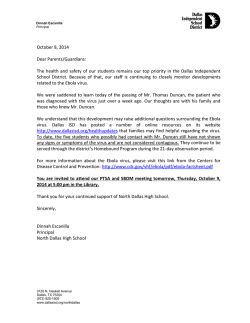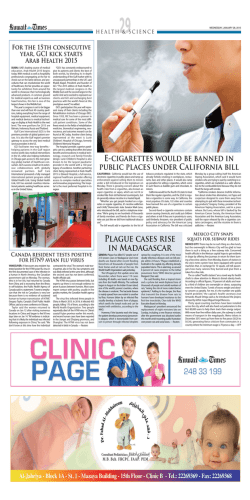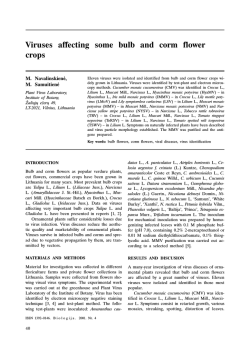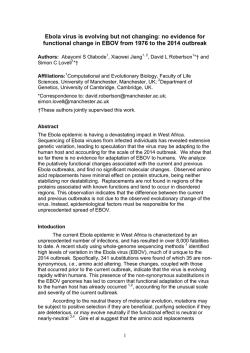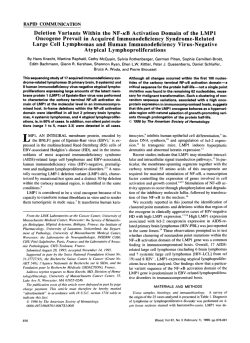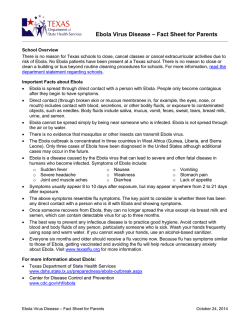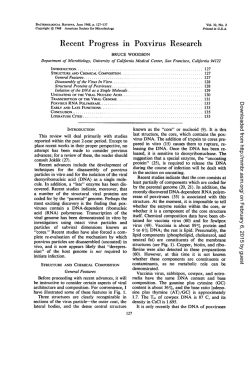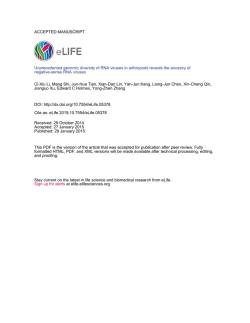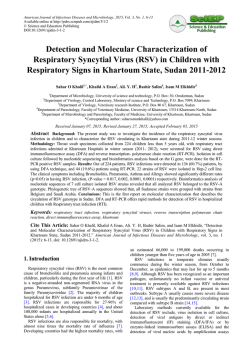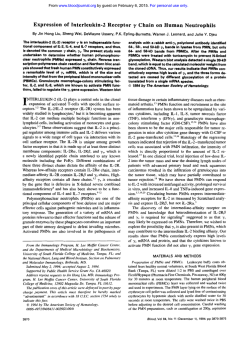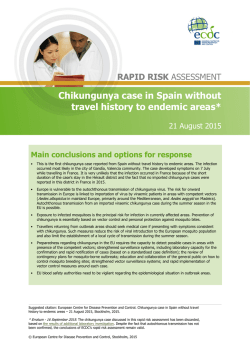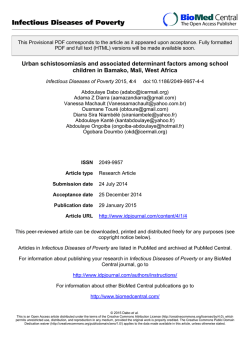
Coxsackievirus B3 Infection in Human Leukocytes
From www.bloodjournal.org by guest on February 6, 2015. For personal use only. Coxsackievirus B 3 Infection in Human Leukocytes and Lymphoid Cell Lines By Tytti Vuorinen, Raija VainionpaB, Hilkka Kettinen, and Tim0 Hyypia 937 cell line with mononudearphagocyticcharacteristics AlthoughCoxsackie B viruses (CBVs) are known to cause was very limited. The virus was able to infect a small proporviremia during acute infection,the role of the blood cells as tion of leukocytes and BM cells, and intracellular virus antia target for virus replication is poorly understood.We have analyzed the susceptibility of human peripheral blood mono- gens were detected by immunofluorescent staining. Howof infectiousviruswas ever,only adiminutiveamount nuclearcells (PBMCS), granulocytes,bone marrow (BM) produced in isolated PBMCs and granulocytes, and no virus cells, and lymphoid cell linesto coxsackievirus B3 infection. protein synthesis was detected by metabolic labeling and Lymphoid cell lines with B- and T-cell characteristics (Raji immunoprecipitationin these cells. and Mot-4, respectively) supported virus replication to high titers and virus protein synthesis was detected by metabolic0 7994 by The Ameriwn Society of Hematology. labeling and immunoprecipitation.CBV3 synthesis in the U- C OXSACKIE B viruses (CBVs), members of the enterovirus group in the Picornavirus family, are important human pathogens and cause a great variety of diseases varying from the common cold to severe and occasionally fatal infections, eg, myocarditis.’ After the initiation of enterovirus infection, the multiplication of the virus in the nasopharynx and in the alimentary tract is known to be often followed by a short viremic phase when the virus can be isolated from the blood. Despite the importance of this phenomenon in the pathogenesis of infection (the blood stream can transfer the virus to secondary target organs, eg, the heart) very little is known about CBV infection in human blood cells. However, it is known that different blood cell types harbor enteroviruses in a different manner. Rather et a12 showed that in 28 patients with coxsackie or other enterovirus infections, virus was isolated from blood in l1 cases and serum was positive in 7, mononuclear leukocytes were positive in 9, and granulocytes were positive in 3 cases. Recently, it was reported that coxsackievirus B3 is able to infect freshly harvested human monocytes and to affect the immunologic functions of the cells.3 On the other hand, Matteucci et a14 observed systemic lymphoid organ atrophy in coxsackievirus B3-infected mice, but were unable to show virus replication in thymus, spleen, and lymph nodes. We report here that, although CBV3 antigens are found in human peripheral blood mononuclear cells (PBMCs), granulocytes, and bone marrow (BM) cells after in vitro infection, the production of newly synthesized viral polypeptides or infectious virus was not detected. However, the lymphoid cell lines with B- and T-cell characteristics are highly permissive to CBV3 infection. 7.5% of monocytes. The granulocyte fraction contained 47% to 66% granulocytes and 11% to 24% lymphocytes. Mononuclear cells were cultured either unstimulated or stimulated with phytohemagglutinin (PHA; 10 pg/mL, Difco Laboratories, Detroit, MI) 4 days before infection. Human BM cells were aspirated from patients at the the Department of Hematology, Turku University Central Hospital. BM cells with morphologically normal appearance were used for virus studies. Cells from at least 4 donors were tested in each experiment. Raji, Molt-4, and U-937 cell lines were originally obtained from ATCC. Infection of cells. PBMCs, granulocytes, and BM cells as well as Raji, Molt4 and U-937 cell lines were infected with the Nancy strain of CBV3 at a low (1 or 5 ) and a high (100) multiplicity of infection (m.0.i.) in 0.2 mL of serum-free Hanks’ balanced salt solution. After the adsorption time of 1 hour, the cells were extensively washed to remove the unadsorbed virus inoculum. Infected and control cells (lo6 celldml) were incubated at 37°C in RPM1 1640 medium, supplemented with 10% fetal calf serum (GIBCO Europe, Glasgow, UK) and 50 pg/mL gentamicin. Lymphoblastoid cell lines, PBMCs, and their supernatants were harvested for infectivity titration and spot hybridization test after different time intervals postinfection ( p i ) during 96 hours, granulocytes were harvested during a 24-hour incubation period, and both were stored at -70°C until analyzed. The cells for the in situ hybridization and immunofluorescence (F)tests were collected after the adsorption time and 1, 2, 3, 4, and 5 days postinfection. Uninfected cells were used as control material. Infectivity titration. The release of CBV3 from infected cells to the culture medium and the amount of intracellular virus was determined on confluent monolayers of LLC-MK, cell cultures in dilutions 10” to lo”* according to the appearance of a CPE. Before inoculation, the cell suspensions were frozen and thawed three times to release the virus and clarified by low-speed centrifugation. The cells were examined for the CPE for 7 days and the results were expressed as end-point titers. MATERIALS AND METHODS Preparation of virus stock. CBV3 (Nancy strain) was originally obtained from American Type Culture Collection (ATCC; Rockville, MD). The virus was propagated in roller cultures of LLC-MK, cells (ATCC), which are Mycoplasma screened at regular intervals. When cytopathic effect (CPE) of 75% to 100% was observed, the cells and the culture medium were collected, frozen, and thawed three times to release the virus, and stored at -70°C. Before use, the cell debris was removed by low-speed centrifugation. Cells and cell lines. Human PBMCs and granulocytes were isolated from healthy adults in Ficoll-Isopaque (Ficoll-Paque; Pharmacia Fine Chemicals, Uppsala, Sweden)/Histopaque-l119 (Sigma Diagnostics, St Louis, MO) double gradients. According to the FAC Scan flow cytometer analysis the mononuclear cell population of five persons consisted of 84% to 94% of lymphocytes and 1.5% to Blood, Vol 84, No 3 (August l ) , 1994: pp 823-829 From theDepartment of Virology and MediCity Research Laboratory, University of Turku, Finland. Submitted February 3. 1993; accepted March 28, 1994. Supported by grants from the Sigrid Juselius Foundation and the Academy of Finland. Address reprint requests to Tytti Vuorinen, MD, Department of Virology, University of Turku, Kiinamyllynkatu 13, SF-20520 Turku, Finland. The publication costs of this article were defrayed in part by page charge payment. This article must therefore be hereby marked “advertisement” in accordance with 18 V.S.C. section I734 solely to indicate this fact. 0 1994 by The American Society of Hematology. 0006-497I/94/8403-0006$3.00/0 823 From www.bloodjournal.org by guest on February 6, 2015. For personal use only. VUORINEN 824 AL Fig 1. Coxsackievirus 63 RNA in infected Raji (A), Molt-4 (61, and U-937 (C) cell lines 24 hours postinfection detected by in situ hybridization. D, E, and F represent corresponding dark fields. Original magnification x 25. In situ hybridization. Ten to 20 pL of cell suspension was transfered onto polylysine-coated microscope slides and dried at room temperature (RT). The cells werefixed in 4% phosphate-buffered paraformaldehyde. Before hybridization, the slides were incubated in0.2 mol/L HCI for 20 minutes; for 30 minutes in 2 X SSC at 70°C; proteinase K (1 mglmL)-treated for 15 minutes at 37°C in 20 mmol/L TRIS-HCI, pH 7.4, 2 mmol/L CaCI2;dehydrated in ethanol series; and air dried. The slides were washed in aqua between the treatments. The cDNA probe. covering most of the coxsackievirus [email protected], 8 16 2LL8 oe...* RAJ1 MOLT- 4 U-937 C 2 B3 genome, was labeled in a nick translationreactionusing "Sdeoxycytidine triphosphate ("'S-dCTP) and "S-deoxyguanosine triphosphate precursors to a specific activity of 1.5 X 1 Ox cpmlmL. IO mmol/L The hybridization solution contained 50% formamide, TRIS-HCI, pH 7.4.600 mmol/L NaCI, I mmol/L EDTA. IO% dex0.1 mglmLrabbit tran-sulfate,0.2 mg/mL salmonspermDNA, tRNA, 0.1 mg/mL total Vero cell RNA, 0.05% bovine serum albumin, and 20 mmol/L dithiotreitol (DIT), and the denatured probe. For each slide, 1.5 X I0"cpm of the probe was used, and the hybridization was performed at 25°C for 48 hours. Then the slides were washed in 50% formamide, 600 mmol/L NaCI. I mmol/L EDTA, I O mmol/L TRIS-HCI,pH 7.4, 20 mmol/L DTT, first briefly four times, then twice for5 minutes at RT and overnight at 30°C. Finally, the slides were washedfor 60 minutes at 55T, followed by two times for 5 minutes at RT in 2 X SSC, 20 mmol/L DTT and dehydrated in ethanol series containing 300mmol/L ammonium acetate. The slides weredriedat42°Candcoated for autoradiography with Nuclear NY), diluted Trackemulsion,NTB3(EastmanKodak,Rochester, 1:1 with 0.6 mol/L ammonium acetate, and exposed at 4°C for 14 days. After developing the film, the cells were counterstained with hematoxylin and eosin. Plasmid vector pBR322 was used as a control probe. Spor hybridization. The proportional quantity of CBV3 RNA in the infected cells was determined as described earlier by Vuorinen et a16 using the following modifications: the CBV3 cDNAprobe' waslabeled with "P-dCTPusing a nick translation kit (GIBCOBRL, Gaithersburg, MD) to a specific activity of 1.5 X IO' cpml pg. After hybridization, the membrane was washed three times for 72 96 120 h.p.i. 4 6-8-.2L-h.p.i. GRANULOCYTES Fig 2. Detection of coxsackievirus 63-specific RNA by spot hybridization in infected Raji, MOM-4, and U-937 cell lines, and in isolated granulocytes after different time intervals postinfection (h.p.i.). C shows uninfected control cells. From www.bloodjournal.org by guest on February 6, 2015. For personal use only. 825 COXSACKIEVIRUS 63 INFECTION infected with CBV3 at a high multiplicity of infection (MOI). After 3 hours p.i.,the cells were cultured for I hour in methionine-free mediumandthen labeled with S0 pCi/mL ”S-methionine. After overnight incubation, lymphoid cell lines and PBMCs were washed with phosphate-buffered saline (PBS) and stored at-70°C until lysed in 0.05 mol/L TRIS-HCI. pH 7.4.0.15 m o l n NaCI, and 0.001 mol/L EDTA. containing I % Tween and I % sodium desoxycholate. The lysates were sonicated for 1 minuteand centrifugated for 10 minutes at 8,OOO rpm to remove insoluble proteins. Protein A-Sepharose CL-4B beads and 20 pL of rabbit CBV3-antiserum were incubated at RT for 60 minutes. The labeled cell lysate was added and the mixture was incubated overnight at 4°C. washed four times with 0. I m o l L TRIS-HCI containing 0.01 % Tween and eluted with 0. I mol/L TRIS-HCI, 2% SDS, 5% mercaptoethanol. The immunoprecipitates were analyzed by electrophoresis in 12% SDS-polyacrylamide gels. The results were shown by autoradiography on an x-ray film for 4 days andby using Phosphor Analyst (Bio-Rad Laboratories, Richmond, VA). Inm,ltnr,fl~ore.~ce,Ice.Thecellswerefixed on slides in acetone at until tested.Thefixedcells 4°Cfor 10 minutesandstoredat-20°C were incubated for 45 minutes at 37°C with rabbit anti-CBV3 serum, diluted 150 in PBS and further stained with fluorescein isothiocyanate (F1TC)conjugated sheepantirabbit IgG (Dako, Glostrup,Denmark). For the double-staining, cells werefirst incubated with the FITC-conjuJose, CA), gatedanti-Leu-M3antibodies(BecktonDickinson,San fixed in acetone at4°C.incubatedwithrabbitanti-CVB3serumand finally stained with tetramethylrhodamine isothiocyanate-labeled sheep antirabbit IgG. The fluorescence was examined using a L e i t z Dialux 22 microscope (E. Leitz, Wetzlar, Germany). -VPO -vp3 A B C D E F Fig 3. Synthesis of virus proteins detected by immunoprecipitation with rabbit antiCVB3 serum. Uninfected Raji cell line (A), CBV3infected Raji cell line IBI, infected Molt-4 cell line (C), infected U 937 cell line (D), infected LLC-MK2 cells(E), and uninfected LLC-MK2 cells (FI. Virus polypeptides VPO, VP1,VP2, and VP3 are indicated by arrows. Molecular-weight markers 46, 30, 21.5, and 14.3 kD are depicted by lines on the left. 5 minutes at RT in 2 X SSC containing 0.I% sodium dodecyl sulfate (SDS) and three times for 30 minutes at42°C in 0.1 X SSC containing 0. I ?+ SDS. Immloloprec.ipirucIrioll. Raji, Molt-4,andU-937 cell lines,LLCMK? cells, as well as stimulated and unstimulated PBMCs were RESULTS Lymphoblnstoid cell lines. The in situ hybridization test was used to show the proportion of cells containing viral PBMC lM.O I O-7 L E 210 2L L0 72 2L8 2L L0 h.p.i 72 96hp1 c a, c c MOLT-L1M01. .-C 0 Q U C W ~O-~F ;lmuIate; L 2 L 8 16 2L 10-5_ L0 72 U-937 lM.O I PBMC ~ M . o . I . ~ ~ O - ~ ~ IM.OT I E 96h.pl 210 10-5- 2Lh.p1 2~ 210 L96h.pl a 72 PHA stlmulated PBMC 100M.O. I I 2L8 21 I La h.p.i 72 L ” 2 L2 h6 p0 1 Fig 4. Production of infectious coxsackievirus B3 in the Raji, MOk-4, and U-937 cell lines, in unstimulated and stimulated PBMCs and in granulocytes. Mean and SD of end-point titers from cells ( 0 )and the culture medium (0) are shown. For PBMCs and granulocytes, results with m.0.i. of 1 and 100 are shown. S From www.bloodjournal.org by guest on February 6, 2015. For personal use only. 826 VUORINEN ET AL Fig 5. Coxsackievirus B3 RNA in infected PBMCs (A), granulocytes (B),and BM cells (C) 24 hours postinfection detected by insitu hybridization. D, E, and F represent corresponding dark fields. Original magnification x 25. RNA after the adsorption time of the virus and 24 hours p.i. (Fig 1). Uninfected cell lines were used as controls. The Molt-4 and Raji cell lines were highly permissive to CBV3 infection, whereas the monocytic cell line U-937didnot show any positive signal. Viral RNA synthesis in the cell cultures was also followed by analyzing the total quantity of CBV3 RNA by spot hybridization (Fig 2). Also in this assay, the Raji and Molt-4 cell lines were observed to support virus RNA synthesis, whereas the monocytic cell line U-937 did not. The synthesis of virus polypeptides VPO, VP1, VP2, and VP3 was detected by immunoprecipitation from Rajiand Molt-4 cell lines after metabolic labeling, but no virus-specific pro::ins were detected in the U-937 cell line (Fig 3). The human lymphoblastoid cell lines with both B- and Tcell characteristics also supported growth of infectious virus to high titers (Fig 4). and the replication cycle was similar to that observed in standard cell cultures used to propagate thevirus. The production of the virus started to increase during the first 4 hours p.i. On the other hand, CBV3 production in the U-937 cell line was very limited or negative (Fig 4). PB leukocytes and BM cells. By the in situ hybridization test (Fig 5). only individual positive cells (=1/1,000) could be detected in cultures of CBV3-infected PBMC and BM cells, and in the spot hybridization test, the signals were under the detection level (data not shown). However, immunofluorescent staining showed the presence of CBV3-antigen-positive cells already after the adsorption time. The proportional number of the positive cells was between 10% and 20%. The number of CBV3 positive leukocytes, both in unstimulated and PHA-stimulated cells remained at a similar level (Fig 6). The same proportion of the cells was positive when lowor high m.0.i. was used. Althoughindividual variation (5% to 25% of positive cells) was observed, when CBV3-infected mononuclear cell cultures of six donors representing different HLA-types were examined, comparable results were obtained. Double staining showedthat some cells of the monocyte population contained virus antigens (Fig 6). No release of infectious virus from PBMC infected with either a low or high m.0.i. wasdetected, and PHAstimulation had no effect on virus production (Fig 4). When 1 0 0 m.0.i. was used, the end-point titers were at a higher level, obviously because of the high concentration of theinoculum virus. No synthesis of virus polypeptides was detected in infected unstimulated or stimulated PBMCs after metabolic labeling and immunoprecipitation (not shown). By IF test, CBV3 positive granulocytes were detected already after 1 hour p i . (Fig 6). and after 24 hours p i , From www.bloodjournal.org by guest on February 6, 2015. For personal use only. COXSACKIEVIRUS B3 INFECTION 827 Fig 6. IF staining of CBV3 proteins in blood cells. Results obtained after the l-hour adsorption and 24-hour culture period are shown. A and B show PBMCs infected with low rn.0.i. C and D show PBMCs infected with high multiplicity (100 m.o.i.1. G and H show PHA-stimulated PBMCs infected with 100 MOL E and F show granulocytes infected with 1 rn.0.i. I and J show BM cells infected with 100 m.0.i. K and L show double staining of PBMCs with antimonocytic antibody (Leu-M3; K) and anti-CVB3 (L). the IF and the in situ hybridization tests (Fig S) showed a proportional number (1/1,000) of CBV3 positive granulocytes. The signals in the spot hybridization test (Fig 2) were weak, obviously detecting only RNA originating from the adsorbed particles. No release of infectious virus to the culture medium was observed (Fig 4). DISCUSSION Viremia is associated with infections caused by a great variety of viruses. In some cases, eg, parvovirus B 19' and human immunodeficiency virus'.' infections, it isknowntobe caused by replication of the virus in defined subgroups of blood cells. Although the target cells responsible for virus replication have not yet been definitely identified, viremia is also common in enterovirus infections. Our earlier studies using a mouse model for coxsackievirus B3 infection showed that extensive viremia occurs during the first days after infection.' However, our attempts to show viral infection of mouse leukocytes were unsuccessful, indicating that the replication may rather take place in local lymphnodes or in secondary target organs. Indeed,the course of the viremic phase correlates well with the destruction of the exocrine pancreas, which could be the source of the virus detected in the blood. However, in human infections, the destruction of thetarget organs isusuallyless extensive, and therefore, other explanations for viremia are needed. CBV3 infection in humanPBMCswas observed to be highly restricted. No distinct release of infectious virus was detected in unstimulated or PHA-stimulated PBMCs (Fig 4). This is different from other infectious viruses, eg, measles virus, where PHA-stimulation extensively increases the synthesis of infectious virus."' The release of infectious CBV3 fromthe granulocytes was also minimalandthe small amount of virus detected during the first 24 hours incubation time may originate from the inoculum. The relativelylow proportion of virus-containing PBMCs can be explained by infection of a subpopulation expressing the virus receptor. It is also evident that the virusenters some cells by phagocytosis or related mechanisms. but does not replicate. Although From www.bloodjournal.org by guest on February 6, 2015. For personal use only. VUORINEN ET AL 828 Henke et a13 observed CBV3 production in infected human monocytes, we have been unable to detect active virus replication in these cells. The IF test also showed CBV3 positive polymorphonuclear cells (Fig 6). It is not known whether these cells have receptors for CBVs or if the viruses are taken into the cells by phagocytosis. For instance, members of another enterovirus group, echoviruses, have been found to change cell membrane structure of granulocytes and alter their adhesion properties.”.” It is possible that infected granulocytes or monocytes may transfer viruses through the circulation to different target organs. Virus infections are known to cause BM failure and the role of hematopoetic cells as a target of virus infections has arisen interest. Parvovirus is able to cause aplastic crisis in patients with hemolytic anemia” and the virus is able to infect precursors of mature erythrocytes in vitro.I4 Dengue virus replicates in BM mononuclear cells in vitro,l5 whereas cytomegalovirus infects stromal cells.16 We observed that human BM cells were infected in vitro by CBV3, but the number of infected cells was low, suggesting that BM does not represent any main target for the replication of the coxsackieviruses. When replication characteristics are concerned, CBV3 differs from polioviruses, which infect Molt4 and U-937 cells, whereas no virus production is observed in Raji cell^."^^^ An important determinant in susceptibility to viral infection is the cell surface receptor. Some of these molecules have already been identified and it is known that the poliovirus receptor is a member of the Ig superfamily that is expressed in many cell types.” Although the CBV receptor molecule has been partially characterized, its exact nature is not known to date? The variability inthe susceptibility ofhuman lymphoid cell lines to these viruses could, at least partly, be explained by the presence of different functionally active receptors onthecell surface. However, other factors may also play an important role because expression of the human poliovirus receptor gene in the developing T-lymphocytes in the thymus of transgenic mice is not sufficient for making these cells susceptible to infection.” We show here that a small proportion of in vitro infected human PBMCs absorb CBV3 antigens, and granulocytes are also able to harbor virus. According to the double-staining IF, the PBMCs finding can be partly explained by the presence of the viral material in a monocyte population. Production of virus polypeptides in PBMCs was not observed by immunoprecipitation even though a high concentration of inoculunl virus was used and no clearly detectable synthesis of infectious virus in the cultured cells occurred. Therefore, the transient viremia cannot be explained by the replication of thevirusin these cells. However, it is evident that absorptiodphagocytosis of CVB3 to the blood cells takes place and it is possible that a small population supports active virus replication. The results are unchanged when very high virus concentrations are used. Further studies using new approaches will be needed to shed light on the possible role oflymph nodes and vascular epithelium as the origin of enteroviruses found in blood during the viremic phase of infection. ACKNOWLEDGMENT We thank Marjut Sarjovaara and Marita Maaronen for technical assistance, Taina Kivela for secreterial help, Dr Reinhard Kandolf for providing us with the CBV3 cDNA probe, and Dr Tarja-Terttu Pelliniemi for the examination of the BM aspirates. REFERENCES 1. Grist NR, Bell EJ, Assaad F: Enteroviruses in human disease. Prog Med Virol 24:114, 1978 2. Prather SL, Dagan R, Jenista JA, Megenus MA: The isolation of enteroviruses from blood: A comparison of four processing methods. J Med Virol 14:221, 1984 3. Henke A, Mohr C, Sprenger H, Graebner C, Stelzner A, Nain M, Gemsa D: Coxsackievirus B3-induced production of tumor necrosis factor-a, IL-ID, and IL-6 in human monocytes. J Immunol 148:2270, 1992 4. Matteucci D, Toniolo A, Conaldi PG, Basolo F, Gori Z, Bendinelli M: Systemic lymphoid atrophy in Coxsackie B3-infected mice: Effects of virus and immunopotentiating agents. J Inf Dis 151 :l 100, 1985 5 . Kandolf R, Ameis D, Kirschner P, Canu A, Hofschneider PH: In situ detection of enteroviral genomes in myocardial cells by nucleic acid hybridization: An approach to the diagnosis of viral heart disease. Proc Natl Acad Sci USA 84:6272, 1987 6. Vuorinen T, Kallajoki M, Hyypia T, Vainionpaa R: Coxsackievirus B3-induced acute pancreatitis: Analysis of histopathological andviral parameters in a mouse model. Br J Exp Pathol 70:395, 1989 7. Kurtzman GJ, Gascon P, Caras M, Cohen B, Young NS: B 19 parvovirus replicates in circulating cells of acutely infected patients. Blood 71:1448, 1988 8. Schnittman SM, Psallidopoulos MC, Lane HC, Thompson L, Baseler M, Massari F, Fox CH, Salzman NP, Fauci AS: The reservoir for HIV-I inhuman peripheral blood is aT cellthat maintains expression of CD4. Science 245:305, 1989 9. Spear GT, Ou C-Y, Kessler HA, Moore JL. Schochetman G, Landay AL: Analysis of lyphocytes, monocytes, and neutrophils fromhuman immunodeficiency virus (HIV)-infected personsfor HIV DNA. J Infect Dis 162:1239, 1989 IO. Hyypia T, Korkiamaki P, Vainionpaa R: Replication of measles virus in human lymphocytes. J Exp Med 161:1261, 1985 1 1. BultmanBD, Haferkamp 0, Eggers HJ, Gruler H: Echo 9 virus-induced order-disorder transition of chemotactic response of human polymorphonuclear leukocytes: Phenomenology and molecular biology. Blood Cells 1079, 1984 12. Kirkpatrick CJ, Bultmann BD, Gruler H: Interaction between enteroviruses and human endotelial cells in vitro, alterations in the physical properties of endothelial cell plasma membrane and adhesion of human granulocytes. Am J Pathol 118: 15, 1985 13. Chorba T, Coccia P, Holman RC, Tattersall P, Anderson LJ, Sudman J, Young NS, Kurczynski E, Saarinen UM, Moir R, Lawrence DN, JasonJM, Evatt B: The role of parvovirus B l 9 in aplastic crisis and erythema infectiosum (fifth disease). J Inf Dis 154:383, 1986 14. Ozawa K, Kurtzman G, Young N: Replication of theB19 parvovirus in human bone marrow cell cultures. Science 233:833, 1986 15. Nakao S, Lai C-J, Young NS: Dengue virus, a flavivirus, propagates in humanbonemarrow progenitors and hematopoietic cell lines. Blood 74:1235, 1989 16. Apperley JF, Dowding C, Hibbin J, Buiter J, Matutes E, Sissons PJ, Gordon M, Goldman JM: The effect of cytomegalovirus From www.bloodjournal.org by guest on February 6, 2015. For personal use only. COXSACKIEVRUS B3 INFECTION on hemopoiesis: In vitro evidence for selective infection of marrow stromal cells. Exp Hematol 17:38, 1989 17. Okada Y, Toda G , Oka H, Nomoto A, Yoshikura H: PolioviN S infection of established human blood cell lines: Relationship between the differentation stage and susceptibility or cell killing. Virology 156:238, 1987 18. Lopez-Guerrero JA, Cabanas C, Bernabeu C, Fresno M, Alonso MA: Poliovirus infection interferes with the phorbol esterinduced differentation of the monocytic U937 cell line. Virus Res 14:65, 1989 19. Roivainen M, Hovi T: Replication of poliovirus in human 829 mononuclear phagocyte cell lines is dependent on the stage of cell differentation. J Med Virol 27:91, 1989 20. Mendelsohn C, Wimmer E, Racaniello VR: Cellular receptor for poliovirus, molecular cloning, nucleotide sequence and expression of a new member of the immunoglobulin superfamily. Cell 56:855, 1989 21. Hsu K-HL, Lonberg-Holm K, Alstein B, Crowell RL: A monoclonal antibody specific for the cellular receptor for the group B coxsackieviruses. J Virol 62:1647, 1988 22. Ren R, Racaniello VR: Human poliovirus receptor gene expression and poliovirus tissue tropism in transgenic mice. J Virol 66:296, 1992 From www.bloodjournal.org by guest on February 6, 2015. For personal use only. 1994 84: 823-829 Coxsackievirus B3 infection in human leukocytes and lymphoid cell lines T Vuorinen, R Vainionpaa, H Kettinen and T Hyypia Updated information and services can be found at: http://www.bloodjournal.org/content/84/3/823.full.html Articles on similar topics can be found in the following Blood collections Information about reproducing this article in parts or in its entirety may be found online at: http://www.bloodjournal.org/site/misc/rights.xhtml#repub_requests Information about ordering reprints may be found online at: http://www.bloodjournal.org/site/misc/rights.xhtml#reprints Information about subscriptions and ASH membership may be found online at: http://www.bloodjournal.org/site/subscriptions/index.xhtml Blood (print ISSN 0006-4971, online ISSN 1528-0020), is published weekly by the American Society of Hematology, 2021 L St, NW, Suite 900, Washington DC 20036. Copyright 2011 by The American Society of Hematology; all rights reserved.
© Copyright 2026
